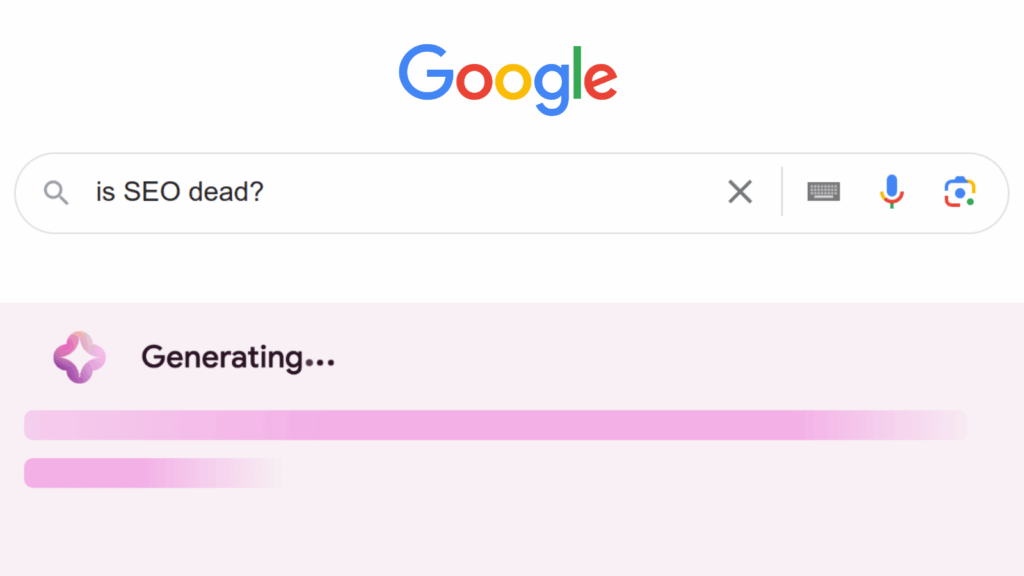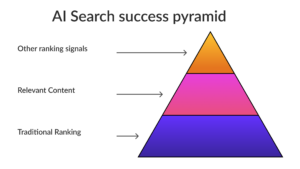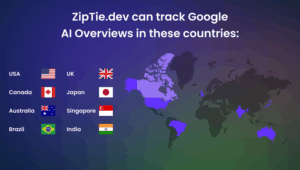Google AI Overviews is the most controversial and anxiety-provoking change in search.
It is already a top focal point for businesses relying on organic search.
We have seen quick adoption of an AI search experience, resulting in the quick rollout of AI Overview, even expanding to 100 other countries and territories recently.
With so much changing week by week and with so few companies actually testing and tracking AI Overviews’s rollout to the public, we put together the following State of AI Overviews to help walk you through all the ins and outs based on the world’s most comprehensive research.
TL;DR
- AI Overviews affects around 12.7% of the most popular queries on average,
- Brand new ranking algorithm: 63% of sources don’t come from top 10 “traditional” search results.
- This point is overlooked most of the time, but extremely important: AI Overviews shifts search from keywords to immersive user journeys and conversation. This means a challenge for keyword tracking and predicting people’s needs on various layers of the user journey.
- It’s not only a danger for companies; Google’s AI Overviews also bring opportunities for smaller players to compete with giants.
AI Overviews explained in 1 minute
AI Overviews is a relatively new feature that attempts to bring all the steps in a user’s journey into one interface, by placing an AI-generated overview right at the top of the search results.
As it’s placed on the top of search results, it effectively catches the attention of Google users.
Now the goal for many businesses is to be featured on AI Overviews.
How will Google AI Overviews impact search?
Here are three main challenges associated with AI Overviews:
- Impact on Clicks and Revenue: AI Overviews takes the top spot, possibly fulfilling user intent. It can lead to fewer clicks and thus, potentially lower revenue
- New competitors. New algo shifts from content to answers effectively promoting new players in search results. According to my research, as much as 63% of sources don’t rank in the top 10.
- Shift from keywords to conversations. It’s more like the experience you know from chatGPT.
I believe the third challenge will emerge over time.
Thanks to AI Overviews Google users can query Google using natural language.
This was not possible through the first 20 years of search engines, as users were forced to be limited to keywords. This is something that most people overlook, but it’s a massive change. My prediction is that it will become an emerging trend.
Now I can tell Google: “I have a Samsung Galaxy S20. I’m looking for a new phone up to 1000 USD with a good camera, I’m interested mostly in landscape photography and good battery life”.
A disclaimer, I’m not an Apple fanboy, it’s just a simulation 🙂 I don’t own a Samsung s20 either.
As a summary of how AI Overviews will impact search, It’s clear that AI Overviews and other AI search interfaces (such as chatGPT) are effective for users and are becoming widely adopted, which means you will continue to see AI Overviews results across most markets including ones associated with your brand.
You cannot escape this change, but you can start working to make sure AI Overviews works for you and your business.
Which countries are covered by AI Overviews?
AI Overviews are already available in 100+ countries and territories.
I created a simple map showing which countries are affected by AI Overviews.
You can find a full, up-to-date list on Google’s website.
Key Google AI Overviews disruptions to prepare for in 2025
We distilled key takeaways from our research to show you areas you should focus on while preparing for the AI Overviews revolution.
Our data indicates AI Overviews appear for around 12.7% queries and that number continues to increase.
This data reflects a huge 500k sample that we rerun occasionally.
Our analysis was focused on the most popular queries bringing the most traffic to websites from specific niches.
We also have a weekly tracker based on a smaller sample, from select niches. You can find it here: https://dashboard.ziptie.dev/aio-monitor
Data from our weekly tracker indicates that some cohorts generate AI Overviews much more frequently than the others, especially if they are with informational intent.
(Commonly, for ZipTie.dev clients who want to know the real impact of AI Overviews on their business, recommend splitting keywords into groups: for instance: top keywords, informational keywords)
With this in mind, you need to really begin focusing on creating content intended to be featured in AI Overviews, or in the immediately surrounding features used in each specific user journey that applies to your customers.
Take the query: “Who is Kim Kardashian dating”. By looking at the AI Overviews response, we can quickly notice what AI Overviews is looking for:
So AI Overviews is looking for:
- Recent info (I took the screenshot in March 2024, and it was referring to sources from February and March).
- Who Kim Kardashian is Dating (Odell Beckham Jr) and who he is.
- Words that can describe their relationship, such as: “palpable chemistry” or “mindful of not being too conspicuous”.
Google has no boundaries
We looked at 10 different industries and found that the three verticals with the highest share of AI Overviews are: Health (54%), Finance (21.2%), Jobs (16.6%)
Here is a breakdown of AI Overviews responses by vertical:
Google AI Overviews and ‘Your Money Your Life’ queries
It surprises me that Google is so willing to generate AI Overviews for health queries (54%).
This prompted me to take a closer look at the Health data by testing queries around very sensitive issues, for instance, cancer-related queries, where accuracy and sensitivity are crucial.
The results blew my mind. AI Overviews appear for 70% of cancer-related queries.
For reference, here is the AI Overviews response for “cure cancer”:
Even if the response is based on trusted sources (such as WebMD), it’s still a very sensitive topic that, at least in my opinion, shouldn’t present any content generated by AI. Instead, it should be presented by certified experts.
If you want to know more about AI Overviews on Your Money Your Life Queries, you can find more insights in my recent article.
It’s clear that AI Overviews will affect most of the industries, including the medical sphere and Your Money Your Life queries.
So businesses of all types should start optimizing for AI Overviews. This way they can increase their visibility and brand recognition.
AI Overviews is the new top 1
As I mentioned, AI Overviews shows up right at the top of the search results, just under any ads.
This setup pushes everything else on the search results page, like the usual top 10 blue links, Featured Snippets and the Top Stories carousels, further down.
Because of this, if your website is listed in the regular Google search results, your customers will have to scroll past the AI Overviews section to find it, which could affect how many people actually see your site.
We looked into how much space AI Overviews takes up on the screen. Our research found that on average, an AI Overviews response uses about 400 pixels of space.
Usually this translates to a notable part of the user display.
More than 6 AI Overviews spots to be taken
On average, the Google AI Overviews response is based on 6.21 sources.
The hotel industry takes into account the largest number of sources (8.45 sources on average), followed by health (6.82) and marketplaces (6.66)
Based on the number of sources in a given industry we can estimate how difficult it is to get into AI Overviews.
Our assumption is that if there are just two sources, Google is looking for basic information from trusted sources, and it’s more difficult to get there with your brand.
Having a big number of AI Overviews sources may indicate Google is looking for a diversified set of sources.
So all things being equal it should be easier to get into AI Overviews when the number of sources is higher.
Follow the above experimental strategy to see if it makes you more successful in Google’s AI Overviews.
AI Overviews means new SEO rules
The above mentioned observation is intriguing for a couple of reasons. It’s now evident that Google AI Overviews operates on a completely different level compared to traditional search. Remarkably, 63% of the sources used by AI Overviews do not appear in the top 10 traditional search results.
Optimizing for AI Overview
As I mentioned, AI Overviews mean new SEO rules.
This means that if you aim to be featured in Google AI Overviews, you’ll need to develop a distinct strategy tailored to this new environment. It’s a whole new game.
Some areas for you to consider:
- Prepare a content strategy to cover various stages of the buying process (at the beginning people don’t type: “buy iPhone 15”, they rather try to find more information about its camera quality, and battery life. To ensure AI Overviews success you should be present at every stage of their journey.
- Prepare content fragments that clearly answer a given query. For instance, users typing “who is Kim Kardashian dating” probably don’t care about her childhood. They want a CLEAR answer. And this is something your content should reflect.
- Technical optimization of the website – it’s important to make your content easily digestible for Google robots. Just as Google search used Googlebot to visit and index pages, now AI Overviews is using Googlebot to source pages for answers to queries.
Summary
As outlined in the article, we expect AI Overviews will revolutionize search and its impact on businesses, and publishers relying on traffic from Google.
It’s a totally new playing field and a different ranking system (meaning you can rank high in AI Overviews, but not rank in traditional search results).
To prepare for AI Overviews you have to prepare a distinct strategy that includes:
- Check which competitors are successful in AI Overviews. You can use ZipTie.dev for this.
- Spend some time trying to analyze what made Google choose them over your content (it could be content quality, content relevancy, or technical SEO optimization. Or maybe they just provide a direct answer that satisfies Google’s AI Overviews? A lot of things come into play and it’s interesting to observe and experiment with what works for AI Overviews and what doesn’t work.
- Improve your content to be featured in AI Overviews.
Methodology
In late October 2024, we utilized our custom-developed software at ZipTie.dev to scrape 490,000 keywords in Google US. The initial step involved selecting industries to ensure a broad coverage of online businesses. The e-commerce sector alone represents a significant portion of various businesses, and we expanded our research to include 10 additional industries, such as health or finance.
For each industry, we identified leading companies and used Ahrefs to determine which search queries they ranked for in “traditional” Google. We then selected keywords for each domain based on their popularity, categorizing them into three groups based on search volume: 100-1,000, 1,000-10,000, and over 10,000. To maintain neutrality and avoid biases toward specific companies, we excluded brand-specific queries.
To ensure accuracy and reliability in data collection, our scraper is designed to retry in case of errors and uses multiple randomly selected accounts, minimizing the impact of personalization.
We conducted our data analysis using three tools: Excel, KNIME, and a custom Python script.






